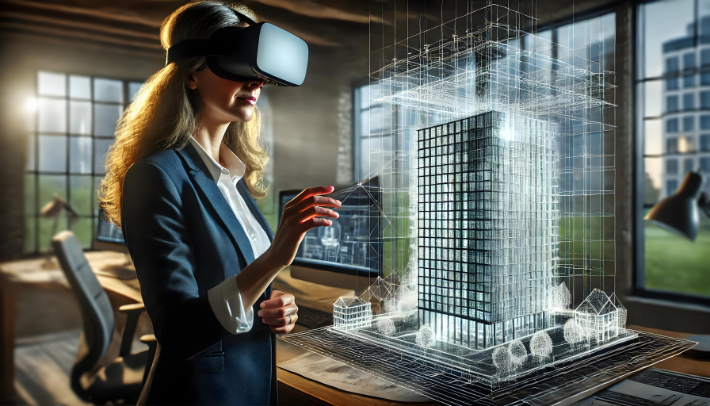Introduction
As digital technology continues to weave into every aspect of our lives, it’s fascinating to observe the similarities between technology design and architectural principles. But what does it mean to apply the mindset of an architect to digital technology? Both architecture and digital design aim to create functional, resilient, and visually appealing structures—whether that’s a building or a piece of software. In this article you Learn “How Is Bringing Digital Technology Out Thinking Like an Architect” enhances design through structure, adaptability, and user focus.
What Does It Mean to “Think Like an Architect”?
To think like an architect is to approach a project with a holistic mindset, understanding that every design choice impacts functionality, sustainability, and the end user’s experience. Architects focus on crafting environments that are functional, sustainable, and visually pleasing. This involves balancing aesthetic and structural elements, planning for future needs, and ensuring that every aspect works in harmony with the others.
The Rise of Digital Technology in Modern Design
In recent decades, digital technology has reshaped various fields, including architecture. Software, 3D modeling, and augmented reality are now integral tools in architectural projects, enabling architects to create realistic models and predict structural behavior. Technology has not only revolutionized design processes but has also made it possible to think more creatively about building and space usage.
Integrating Architectural Principles with Digital Technology
Applying architectural principles to digital projects involves thinking structurally and strategically about software and hardware solutions. For instance, just as a building requires a stable foundation, digital platforms need strong, scalable back-end infrastructure. Scalability, modularity, and adaptability, which are essential in architecture, are equally vital in tech, allowing digital platforms to grow and evolve seamlessly.
Planning with the End User in Mind
In both architecture and digital technology, the user experience is key. Architects consider how people will move through and interact with spaces, just as digital designers think about user interaction within a platform. Embracing a user-centered design approach ensures that both buildings and digital systems are intuitive, functional, and accessible, promoting a positive user experience.
The Role of Spatial Awareness in Digital Solutions
Architects are naturally skilled in spatial awareness, a skill that translates effectively into digital design. For instance, UX/UI designers incorporate spatial thinking when planning navigation, button placement, and content layout. Understanding digital “space” allows designers to create intuitive and engaging digital environments that are easy for users to navigate.
Creating Stability and Balance in Digital Platforms
Stability and balance are as crucial to software as they are to physical structures. A balanced digital platform minimizes risk, optimizes resource usage, and enhances user experience. For instance, balanced data handling, load distribution, and responsiveness keep systems stable, while architectural principles guide designers in creating well-rounded, robust platforms.
Incorporating Aesthetic Principles in Technology
In architecture, aesthetics matter just as much as structural integrity. Similarly, digital designers use color theory, typography, and visual hierarchy to create aesthetically pleasing interfaces. By blending form with function, digital designs become more appealing, engaging users while ensuring functionality.
Building for Adaptability and Future Growth
Both architects and digital designers must anticipate future needs. Just as buildings need room for future expansion, digital solutions need to adapt to evolving demands. The modularity of digital products, much like adaptable building designs, ensures that technology can grow without losing stability or integrity.
Leveraging the Power of Visualization
Visualization is a fundamental skill in both architecture and technology. While architects use sketches, blueprints, and 3D models to communicate ideas, digital designers use data visualization tools, AR, VR, and prototyping software to test and refine digital products. Visualization tools help bridge the gap between concept and reality, making ideas more tangible.
Balancing Form and Function
One of the timeless principles shared by both fields is the balance between form and function. An aesthetically pleasing structure that lacks functionality doesn’t serve its purpose—whether it’s a building or a website. Great digital design marries visual appeal with seamless functionality, ensuring that users get both beauty and usability.
Environmental and Sustainability Considerations
Sustainable practices are becoming increasingly relevant in both architecture and technology. Architects work with eco-friendly materials and energy-efficient designs, while digital companies focus on minimizing energy consumption in data centers and designing software with low resource requirements. Sustainability is key to creating responsible, long-lasting designs.
Using Collaboration Tools as a Digital Blueprint
The architectural blueprint serves as a roadmap for construction, and in digital projects, collaboration tools act as the blueprint. Platforms like Trello, Asana, and Figma streamline project planning and enable teams to visualize progress, ensuring everyone remains aligned—much like an architect guiding construction from concept to completion.
Challenges of Bringing Digital Technology Out with an Architectural Mindset
Integrating architectural principles into digital technology isn’t without challenges. The main obstacle lies in balancing the technical constraints of digital platforms with the creative aspirations of architectural thinking. However, these challenges can be overcome by encouraging cross-disciplinary collaboration and fostering a culture of innovative problem-solving.
Conclusion
Bringing architectural thinking into digital technology provides a structured, creative approach that results in better-functioning, aesthetically pleasing, and sustainable digital products. By thinking like architects, digital designers can create systems that not only perform well but also engage users, promote scalability, and respect environmental considerations. As technology continues to advance, this approach will only become more valuable, bridging the gap between design and functionality in digital spaces.
FAQs
1. How can architectural principles improve digital technology?
Architectural principles bring structure, aesthetic consideration, and user-centric design to digital technology, enhancing both functionality and user experience.
2. Why is spatial awareness important in digital design?
Spatial awareness helps digital designers organize layouts intuitively, making user interfaces easier to navigate and improving overall user experience.
3. Can architectural thinking make digital systems more sustainable?
Yes, architectural thinking emphasizes sustainability, encouraging eco-friendly practices in data management, software design, and energy usage.
4. What tools help integrate architectural thinking into digital projects?
Collaboration tools like Figma, Trello, and Asana, as well as visualization tools like AR and VR, enable digital teams to plan and design efficiently.
5. How can digital designers think more like architects?
Digital designers can think like architects by focusing on user experience, scalability, and visual appeal while ensuring that their designs serve a practical purpose.




